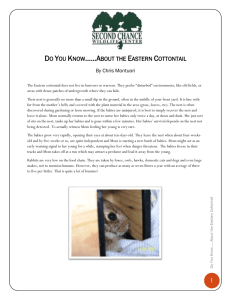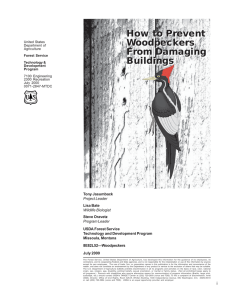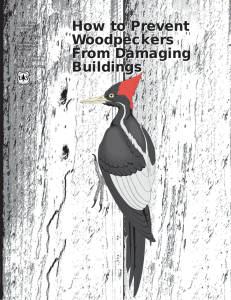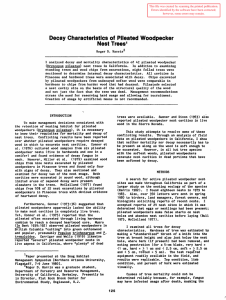From One Extreme to Another - Second Chance Wildlife Center
advertisement
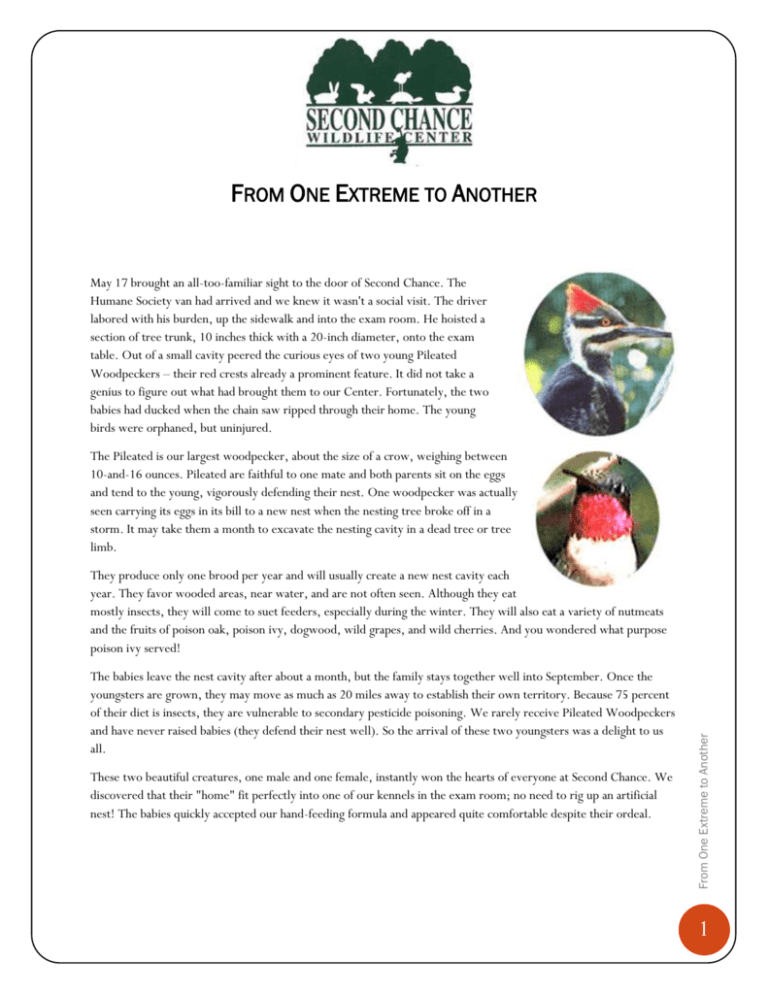
FROM ONE EXTREME TO ANOTHER May 17 brought an all-too-familiar sight to the door of Second Chance. The Humane Society van had arrived and we knew it wasn't a social visit. The driver labored with his burden, up the sidewalk and into the exam room. He hoisted a section of tree trunk, 10 inches thick with a 20-inch diameter, onto the exam table. Out of a small cavity peered the curious eyes of two young Pileated Woodpeckers – their red crests already a prominent feature. It did not take a genius to figure out what had brought them to our Center. Fortunately, the two babies had ducked when the chain saw ripped through their home. The young birds were orphaned, but uninjured. The Pileated is our largest woodpecker, about the size of a crow, weighing between 10-and-16 ounces. Pileated are faithful to one mate and both parents sit on the eggs and tend to the young, vigorously defending their nest. One woodpecker was actually seen carrying its eggs in its bill to a new nest when the nesting tree broke off in a storm. It may take them a month to excavate the nesting cavity in a dead tree or tree limb. The babies leave the nest cavity after about a month, but the family stays together well into September. Once the youngsters are grown, they may move as much as 20 miles away to establish their own territory. Because 75 percent of their diet is insects, they are vulnerable to secondary pesticide poisoning. We rarely receive Pileated Woodpeckers and have never raised babies (they defend their nest well). So the arrival of these two youngsters was a delight to us all. These two beautiful creatures, one male and one female, instantly won the hearts of everyone at Second Chance. We discovered that their "home" fit perfectly into one of our kennels in the exam room; no need to rig up an artificial nest! The babies quickly accepted our hand-feeding formula and appeared quite comfortable despite their ordeal. From One Extreme to Another They produce only one brood per year and will usually create a new nest cavity each year. They favor wooded areas, near water, and are not often seen. Although they eat mostly insects, they will come to suet feeders, especially during the winter. They will also eat a variety of nutmeats and the fruits of poison oak, poison ivy, dogwood, wild grapes, and wild cherries. And you wondered what purpose poison ivy served! 1 On June 16, we received another unusual pair: two nestling Ruby-throated Hummingbirds. These tiny jewels were discovered by a National Park Service tree worker riding around in the back of his bucket truck during storm damage cleanup. Apparently, the babies had been washed from their nest and landed in the bucket. The tree worker had fed them a Gatorade-type preparation every 20-30 minutes all during his work day until he could deliver them to Second Chance at about 7:00 PM. Hummingbirds could not be more different than our large Pileated babies. Unlike the faithful woodpecker, the hummers are a lusty lot, mating indiscriminately. Once the preliminaries are over, Dad departs seeking other conquests, while Mom does all the work of nest building, incubating and tending the young. Using the husks from buds and some lichen from siding, she binds her nest together with spider's silk, and lines it with soft plant down. The size of a walnut (1 to 1-1/4 inches in diameter), the tiny nest usually takes about a week to complete. This is hard work for the single female and she will re-use the nest for each of her 2-3 annual broods. In fact, she will return to the nest each year and, with a little refurbishing, can use it over and over. Hummingbirds are one of our smallest birds and the Ruby-Throated is the only one to nest east of the Mississippi River. Full grown, they are only 3 to 3-1/2 inches long with an enormous wingspread of 4 to 4-3/4 inches. They weigh between 2.5 and 4.5 grams (1/10th to 1/7th ounces), but are ferocious when defending their nest and babies. They will battle bumblebees over feeding rights and will attack and chase kingbirds, crows and even eagles that stray into their territory. Most people think of hummingbirds as eating only "sugar water" but, in fact, they eat a variety of insects as well. Nectar-bearing flowers often attract small gnats and other insects that the hummers consume and they will also steal bugs entangled in spider webs. They will even eat the spider, but they must be careful not to become stuck in the web themselves. We prepared a small "nest" and placed these wee babes in a plastic container. They were kept easily accessible to make the half-hour feedings less of a chore. The little hummers appeared none the worse for their ordeal and readily accepted the specially balanced nectar that we always keep on hand. Weighing only a couple of grams, it would be a challenge to keep up with their needs. From One Extreme to Another In the meantime, the young woodpeckers were growing like weeds and were no longer content in their log nest. We moved them into a large cage on our porch and watched with delight as they clung to the screen sides. Their raucous calls always startled visitors to our Center until we reassured them that it was simply the woodpeckers reminding us they were there. 2 Time passed and our special babies continued to grow. The woodpeckers pecked vigorously on their cage, which threatened to give way under their blows. Time to move them outside but first, some modifications were necessary. Our outdoor flight cages are set up for small to medium perching birds, so they have a variety of horizontal branches. Woodpeckers live in a vertical world so the branches were replaced with large tree trunks and old fence boards. Once the redecorating was completed, the cage was ready for its redheaded tenants. Now, their calls resonated around the property and we were grateful our human neighbors are some distance away. The birds were flying and clinging well and were taking solid food from our hands. They were given a dish of food and a bowl of mealworms but, being woodpeckers, they were reluctant to go down to the ground to feed. On the other hand, they were quite capable of chipping large chunks of wood out of trees and cage alike. Their flicking tongues suggested they knew where to find food; we just weren't able to provide it in that fashion. Still, both birds happily accepted our hand feedings and continued to grow and gain strength. The hummingbirds, too, were growing and gaining strength; in fact, they were flying out of their small container. We have a hand-made cage that has soft nylon screening on the sides, so we set that up for our little jewels. We hung feeders and decorated with fresh flowers to give them the opportunity to self-feed. They took to the flowers instantly, probing for nectar with their long, thin tongues. By July 7, both little hummers weighed a whopping 3.3 grams, and we reduced our hand feedings to hourly. After several weeks outside, we noticed the woodpeckers were bending their tail feathers and began to worry that they would damage their plumage. We had arranged their flight cage as best we could, to minimize feather damage, but we cannot recreate nature. The summer of 1998 had been especially pleasant. Long stretches of sunny days, low humidity and moderate temperatures had enabled us to release birds as soon as they were ready. Often, the weather conspires against us with predictions of afternoon thunderstorms for day after day. We cannot release animals if severe weather is forecast, but this year was different. On July 24, the female woodpecker made our decision easy when she dashed out of the cage as a volunteer entered. We decided to release the male as well; perhaps they would stay in the area and we could provide a little post-release support. The male quickly joined his sister in the large trees surrounding the property. They called joyfully to each other and we crossed our fingers. Although the little hummingbirds could not be watched, the woodpeckers remained very much in evidence. Soon after release, the male flew over to a tree in the front yard and began calling. The female, being slightly more timid, followed and we were thrilled to be able to continue feeding these magnificent creatures. Their begging soon became commonplace and we could often be found standing next to a tree offering food to these two now full-sized, woodpeckers. Their feathers were in great shape and their flight skills seemed perfect. As time passed, they asked for food less frequently but, at this writing, they were still looking for a handout several times a day. We were able to hang a container of food on their favorite feeding tree that allowed them to help themselves whenever they wished. As we have not noticed Pileated Woodpeckers in the area, perhaps they will establish their own territories here on the property. From One Extreme to Another At the same time, we had been pondering where to release our hummingbirds. Perhaps an area with hummingbird feeders would be appropriate but, no, hummers are territorial and the resident birds would probably drive away our youngsters. Releasing them at Second Chance was a possibility; we could hang up feeders and keep an eye on them. We had, however, never seen hummingbirds at the Center; perhaps this wasn't the best place either. Finally, I thought of Meadowside Nature Center. They have a lovely butterfly garden, which is frequented by hummingbirds. With all the different blossoms to choose from, the youngsters would not be invading a feeder already claimed by the resident birds. The hummers were eating entirely on their own and their weights had stabilized at 3.1 grams and 3.6 grams. The staff at Meadowside were happy to assist with the release and our two iridescent jewels were returned to their rightful place in the wild so after the woodpeckers had vacated their cage. 3 So, if you visit Meadowside Nature Center and see two hummingbirds sipping nectar from the flower blossoms, perhaps they are our special babies. And, should you stop by Second Chance and a large, black bird swoops past you and gives a maniacal laugh from a nearby tree, don't be alarmed; it is just our own Heckle or Jeckle dropping in to say hello! These were four unique babies out of the hundreds that arrive at our Center each year. Raising and releasing these beautiful birds makes all the hard work worth every minute of effort. From One Extreme to Another Reprinted from "Second Thoughts" newsletter – Summer 1998. Copyright 1998 - Second Chance Wildlife Center, Inc. 4



